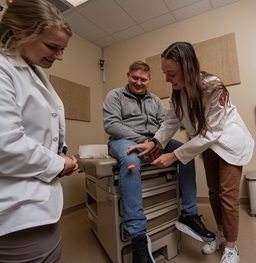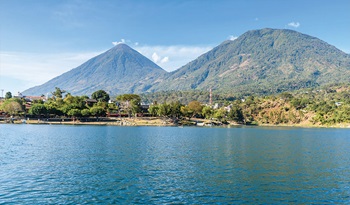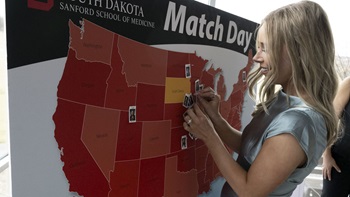About Us
School History
More Than a Century of Service
Since 1907, the Sanford School of Medicine (SSOM) has served South Dakota as its only school of medicine, providing high quality medical education with compassion and innovation.
We strive for excellence in education, research and service. The SSOM Data reference Card highlights the current enrollment of the medical school as well as the economic impacts the school has on the state and region.
Humble Beginnings
Our school began as a two-year medical program with two students enrolled. The following year enrollment grew to four first-year and seven second-year students.
The school’s first dean, Dr. Christian Peter Lommen, started what would become a long tradition of dedicated, public-spirited medical school deans.
By 1925, the class of 20 students and the school was recognized as one of the finest two-year medical institutions in the nation. The school continued to grow and in 1955, class size increased to 40 students.
Program Expansion
By the late 1960s, South Dakotans began to explore the value of a two-year medical program, and medical school advocates proposed expanding the school to a four-year, M.D.-degree-granting institution. A campaign that would accomplish that was led by Medical School Dean Dr. Karl Wegner and South Dakota State Sen. Harvey Wollman. In 1974, the state legislature and Gov. Richard Kneip endorsed the four-year program and in May 1977, the Sanford School of Medicine’s first four-year graduates--39 of them--received their M.D. degrees.
The new four-year institution used a “school without walls” approach, an innovative concept that utilized existing hospitals and clinics as classrooms for third and fourth-year students.
To date, we have matriculated more than 4,000 physician graduates.
Research Emphasis
Research at our medical school assumed new importance in the 1990s and funded research has grown from $5.3 million in 1996 to $16.8 million in 2024. Academic and research faculty are using state of the art teaching and research techniques to not only teach our learners but to conduct translational research that can be applied to treating patients in South Dakota and beyond.
In 2006, we launched a seven-year M.D./Ph.D. program to train future physician scientists. Most recently, an Academy for Medical Student Scholarship and a central office for research were created to provide and oversee research projects for medical students. The number of students participating in research has increased dramatically over the past few years and resulted in completed projects, publications and presentations at scientific meetings.
We continue to drive our focus on research for faculty and students forward.
Contemporary Medical Education
Today’s medical school occupies advanced facilities in Vermillion and Sioux Falls. Students also learn at partner hospitals in Rapid City, Yankton and Sioux Falls. Selected students voluntarily participate in the FARM program, in which they serve nine months in a rural South Dakota community.
In 2013, the medical school underwent an extensive curriculum reform, transitioning from a traditional model of two years of biomedical and translational science followed by two years of clinical practice to a Three Pillars model. Two years of biomedical science was shortened to 18 months constituting Pillar 1. Pillar 2 emphasizes a longitudinal integrated clerkship (LIC) where students learn alongside interprofessional teams in outpatient settings. Pillar 3 allows students to explore their interests as student-physicians and learn independently.
Throughout its history, the medical school has distinguished itself as an innovative leader in medical education, rural medicine, and research. This tradition of excellence continues, creating a vibrant, modern institution.
About Us
Campus Locations
Sioux Falls
Home to the Wegner Health Science Information Center, the state’s premier medical library, the Sioux Falls campus houses medical school administration and clinical departments. The Parry Center for Skills & Simulation is also located here.
Yankton
Next to Yankton Medical Clinic and Avera Sacred Heart Hospital, the Yankton Campus is the birthplace of our innovative Yankton Ambulatory Program.Vermillion
Nestled on the University of South Dakota campus, the Andrew E. Lee Medical Building is home to the Division of Biomedical and Translational Sciences and where our students study for the first 18 months of medical school.
Rapid City
Located near the beautiful Black Hills, the Monument Health Rapid City campus has been providing training for third- and fourth-year medical students since 1948.
The University of South Dakota Sanford School of Medicine is nationally known for excellence in medical education. With its award-winning curriculum, our school prepares medical students to practice in all fields of medicine and is particularly recognized for its reputation in family medicine and rural medicine. In addition to the M.D., we offer graduate degrees in biomedical science, sustain a vibrant and forward-looking research agenda, and are home to the interdisciplinary Center for Brain and Behavioral Research.
Mission Statement
The Mission of the University of South Dakota Sanford School of Medicine is to provide the opportunity for South Dakota residents to receive a quality, broad-based medical education with an emphasis on family medicine. The curriculum is to be established to encourage graduates to serve people living in the medically underserved areas of South Dakota, and is to require excellence in the biomedical sciences and in all clinical disciplines. The University of South Dakota Sanford School of Medicine is to provide to its students and to the people of South Dakota excellence in education, research and service. To these ends, the school is to provide educational pathways leading to both the Doctor of Medicine and the Doctor of Philosophy degrees. Quality health care for the people of South Dakota is addressed by undergraduate, graduate and continuing educational programs as well as by biomedical and applied medical research. The School of Medicine should serve as a technical resource in the development of health care policy in the state and provide extension and research initiatives to improve the health care of the citizens of the state.
Vision Statement
The University of South Dakota Sanford School of Medicine will be a leader in educating students who with knowledge, skill, and compassion dedicate their lives to the well-being of their patients, their community, and their profession.
Opportunity Statement
The University of South Dakota Sanford School of Medicine is committed to fostering a dynamic and welcoming learning environment for all. Therefore, the medical school is committed to both recruitment and retention of students, residents, faculty, and staff who through their intellectually and ideologically diverse perspectives enrich the learning environment. We provide equal opportunities for all. We value people with broad life experiences, with records of service to disadvantaged populations, and with other attributes that may enhance the learning community.
Our students participate in service learning throughout their training.
Coyote Clinic
Our students created the Coyote Clinic in downtown Sioux Falls. The clinic provides health care for uninsured and low income residents.
Scholarship Pathways Program
A service track within the Scholarship Pathways Program enhances our medical student experience. Students grow their community service and leadership development.
Other Service Opportunities
We've also had students participate in:
- International health care experiences around the globe, including a medical mission trip to Guatemala and the Legacy Trip.
- Volunteering as part of the cultural immersion project at settings that include Indian reservations, Hutterite colonies and care facilities for the disabled, deaf and blind.
- Administering flu shots to elementary students as part of a statewide initiative.
- Training to deploy in case of a health care emergency.
- Organizing charity events to raise money for scholarships and domestic violence shelters.
Our leadership team provides guidance for over 300 academic faculty and more than 2,500 clinical faculty across the state.


.png?rev=44d89004ae6341de830361e85f3d6df0&w=740&la=en&hash=367A688D26362CB4266185F8129C9ADE)


